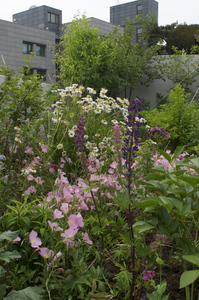

Trevor Curtis designed this roof garden in Seoul, South Korea.
Most artists use paints or ink on canvas or paper, or sculpt in clay or metal. Their mediums are permanent and unchanged by the seasons or owners. Trevor Curtis' is much more ephemeral. Plants are his palette, and soil is his canvas.
Curtis is a landscape architect who combines science and art to create living artwork. "It's like a kinetic sculpture," he says. "It has color and texture and movement. The foliage and flowers are always changing, and it continues throughout the season. It's different from day to day," he says.
Born in Wise County, Virginia, he gained his love of landscaping from his grandparents. One grandmother and a great grandmother were landscape designers who also bred plants.
"They started me gardening at around 5 or 6. I'd be outside, and I'd put sticks in the ground and watch for leaves. It was interesting to do as a child. They would guide me and teach me the names of things."
After Curtis graduated from high school, he went to Virginia Tech where he studied landscape architecture. He studied Sustainable Urban Horticulture and Sustainable Urban Agriculture at the University of Guelph, Ontario, Canada. His studies also included art classes.
"Many landscape architects/designers have a background in art. Roberto Burle Marx is a great example. He studied painting in Germany and returned home to Brazil and revolutionized their garden culture," Curtis says.
After graduation, Curtis spent five years working through Asia before returning home. "The economy wasn't in great shape when I graduated, so I worked for a design firm that did projects all over the world. I designed a lot of projects in the United Arab Emirates and Asia," Curtis says.
He says that there are cultural differences in what people want in their landscapes. For example, his clients in the UAE and Middle East wanted plants that required substantial amounts of water to show that they could afford to keep them watered in the desert. Clients in Japan wanted quality plants and were very patient. They were willing to start with a small plant and train it into a beautiful specimen.
He returned to Bristol because he missed home. "I feel like a lot of people who leave here need to come back and improve the quality of life here." Curtis is doing his part by improving the landscape. He would like for the region to embrace garden tourism, similar to Charleston, South Carolina.
"Abingdon and Bristol have a great opportunity for garden tourism, if they'd welcome it more. People drive hundreds of miles to visit the gardens in Charleston. I think we could do the same thing, if we'd embrace the historic style more. I'm researching the historical plants that would have been grown here and encouraging their planting."
When designing a landscape, he looks at the site and the architecture of the home or business. Then he talks to the client to see what they are interested in. "I'll ask them where they grew up and what kind of plants they had then. I'll include those in the landscape to remind them of their childhood home," he says. He also tries to include plants that are appropriate to the architectural style of the home.
"If you have a federal house that eliminates a lot of plants. I'll use boxwoods, yews, laurels," he says.
In order to create his designs, Curtis considers not only what it will look like when it's planted but also what will happen to it through time. He usually makes five-year, 10-year and 15-year plans and leaves instructions with his clients of when plants will need to be pruned or divided.
When he begins planning, he takes pictures of plants and begins to arrange them on a board. He looks at colors and textures and their growing conditions (e.g. shade). Then he takes into account the timing and length of blooms, what they'll look like at different times of the day and how they'll overlap. He also looks at textures. His landscapes are designed to be visually interesting through the four seasons. Unlike a painter, he then has to factor in sun, soil, water and maintenance.
He also takes into account senses other than sight. "It's not just about color, pattern and texture," he says. "There are also the sound and fragrances, all of which combine to make a garden a relaxing space."
Landscape artists are the only artists whose creations change and whose owners can alter them. For example, he says that some homeowners cut back ornamental grasses in the winter. "I think they're beautiful with frost on them and they provide movement, but some people prefer a manicured look." He's also had homeowners who add plants that don't fit in the garden at all.
"It's hard to turn them over to people sometimes. You spend days and days thinking about plant combinations and weeks working on colors and textures and then they add something that doesn't fit. But others are great and will call and say it's beginning to look overgrown. I'll go and give them tips on what needs to be divided or how to prune something," he says.
Curtis' style is to use native plants and approach the design as if it were a painting. "If you look at a garden for a year, it's a piece of music. A flower comes up, and then a bunch more comes up. It's exciting, like a crescendo in a piece of music," he says. "I look at the site as if it were a canvas that I'll paint."
For more information about Curtis, visit www.studiobotanique.com.